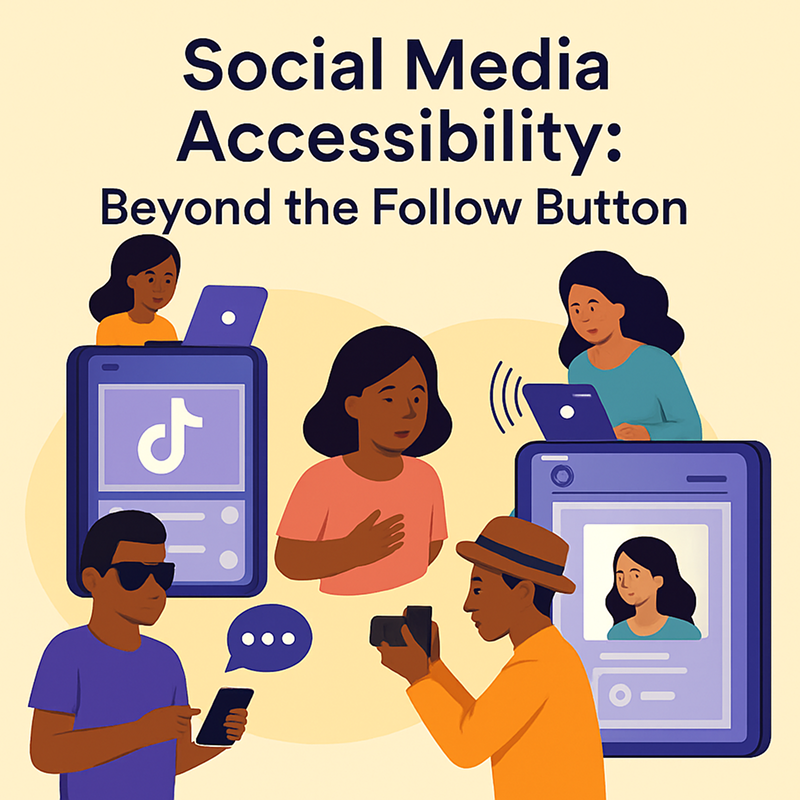Don't Let Your Social Media Be an Afterthought: 5 Tips for Truly Inclusive Engagement
Your commitment to accessibility shouldn’t end at your website’s footer. Here’s how to extend inclusivity to your social media channels, where brand voice and user experience collide.
In 2025, a strong digital presence is non-negotiable. Businesses meticulously craft their website experience, optimizing every button and banner for compliance and user engagement. But what happens when a user clicks away from your perfectly accessible website and lands on your social media? Too often, the commitment to inclusivity falls short.
Your social media is an extension of your brand's front door. It’s a dynamic space for conversation, community-building, and customer service. If it isn't accessible, you're not just failing a portion of your audience; you're communicating that inclusivity is a feature, not a core value. Let's fix that.
Here are five actionable tips to ensure your social media presence is as welcoming and compliant as your website.
1. Master the Art of Alt Text
Every image you post, from product shots on Instagram to team photos on LinkedIn, needs alternative text (alt text). This descriptive text is read aloud by screen readers, allowing users with visual impairments to understand the content and context of your images.
- How to do it right: Be descriptive but concise. Instead of "chart," write "Bar chart showing a 45% increase in user engagement in Q3 2025." Most platforms, including LinkedIn, X (formerly Twitter), and Instagram, have a built-in feature to add alt text. Use it. Every time.
2. Make Your Hashtags Readable with CamelCase
Long, run-on hashtags are a nightmare for screen readers. When you write #digitalaccessibilityforall, a screen reader may pronounce it as a single, jumbled word. By capitalizing the first letter of each word (#DigitalAccessibilityForAll), you create what’s known as CamelCase.
- Why it matters: This simple change allows screen readers to identify and announce each word individually, making your hashtags understandable for everyone. It also improves readability for all users, making your content clearer at a glance.
3. Captions Are Non-Negotiable for Video
Whether it's a 15-second Reel or a 5-minute product demo, all video content must have accurate, synchronized captions. A significant portion of users watch videos with the sound off, and for those who are deaf or hard of hearing, captions are the only way to access the information.
- Best Practice: Don't rely solely on auto-generated captions, which are often riddled with errors. Review and edit them for accuracy. For important content, consider providing a full transcript as well.
4. Write Descriptive Link Previews
When you share a link, platforms like LinkedIn and Facebook generate a preview card. The text on this card is often pulled from the linked page's metadata. Ensure this text clearly describes where the link leads. Vague phrases like "Click Here" or "Learn More" are not helpful.
- Wawsome's Take: Your website's content management system (CMS) should allow you to edit the meta title and description for each page. Craft these with both SEO and accessibility in mind, so when a link is shared, the preview is instantly informative.
5. Use Emojis and Special Characters Thoughtfully
Emojis can add personality, but overuse can create auditory clutter for screen reader users. Each emoji has a verbal description (e.g., "clapping hands sign"), and hearing "clapping hands sign, clapping hands sign, clapping hands sign" is distracting.
- Simple Rule: Use emojis to supplement your message, not replace it. Place them at the end of your sentences or paragraphs to avoid disrupting the flow of your text.
Beyond the Feed: A Holistic Approach
Social media accessibility isn't about checking off a list; it's about integrating inclusivity into your brand's DNA. Just as Wawsome ensures your website provides an equitable experience for every visitor, these practices ensure your brand voice remains consistent and welcoming across all platforms.
By treating social media with the same diligence as your website, you reinforce your commitment to accessibility, build deeper trust with your audience, and truly lead the charge in creating a more inclusive digital world.
